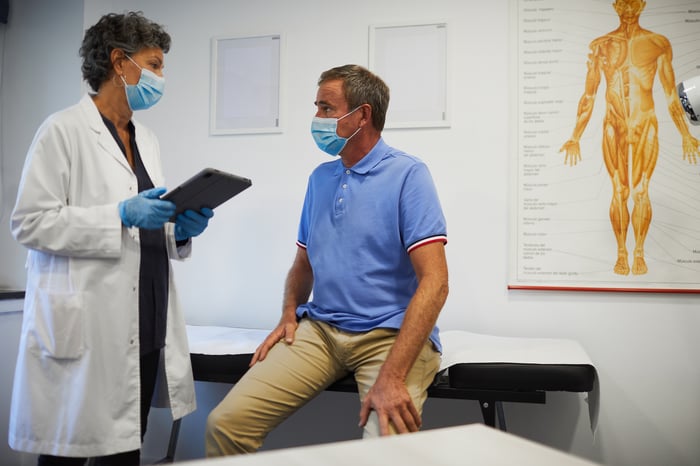On May 20, the U.S. Food and Drug Administration (FDA) approved Sanofi (SNY 2.00%) and Regeneron's (REGN 0.32%) Dupixent as a treatment for patients, aged 12 years and older, with eosinophilic esophagitis (EoE).
What was the data that prompted the FDA to make Dupixent the first and only medicine approved to treat EoE in the U.S.? And what is the sales potential of this indication for the pharma stock Sanofi? Let's dive into the clinical trial results and the EoE market to answer these questions.
A potent treatment for a disruptive disease
EoE is an inflammatory disease that harms the esophagus and prevents it from working properly. The esophagus is the tube that connects the throat to the stomach. Patients with the condition experience an immune system reaction in which a type of white blood cell (eosinophil) accumulates in the esophagus. The symptoms of EoE include dysphagia (difficulty swallowing), central chest pain that doesn't respond to antacids, and food that is stuck in the esophagus after swallowing.
Common first-line treatments for the disease include acid blockers like proton pump inhibitors (PPIs) and topical steroids that are swallowed. Unfortunately, 30% of patients have symptoms that persist with PPIs and topical steroids.
The good news for these patients and their doctors is that there is now another treatment option. Dupixent is now specifically approved in the U.S. to treat patients with EoE that still experienced symptoms on multiple other treatments.
Sanofi and Regeneron enrolled 240 patients with the disease, ages 12 and up, in its phase 3 clinical trial. These patients were randomized into part A and part B, and those in these two groups were then randomized to either receive 300 milligrams (mg) of Dupixent weekly or 300 mg of placebo each week.
Part A and part B patients taking 300 mg of Dupixent weekly experienced much greater reductions in disease symptoms from their pre-treatment baseline than those assigned to receive 300 mg of placebo each week. The Dysphagia Symptom Questionnaire (DSQ) is viewed as a reliable patient-reported outcome of the dysphagia associated with EoE. At week 24, part A and part B patients taking Dupixent achieved respective reductions in disease symptoms of 69% and 64%. This was far superior to the 32% and 41% symptom reduction rates in the groups receiving placebo.

Image source: Getty Images.
Near-blockbuster sales potential
Dupixent has demonstrated that it could be an impactful treatment for countless patients with EoE. But how much could it haul in for Sanofi in the U.S.?
Of the 160,000 EoE patients in the U.S., 30% still have symptoms after other treatments. This is equivalent to 48,000 patients. And due to Dupixent's distinction as the only medication approved for EoE and the marketing might of Sanofi and Regeneron, I believe the drug could capture 60% of that patient share. This equates to 28,800 patients.
Though most patients don't pay the full list price for Dupixent, the drug has an annual list price of nearly $41,000 in the U.S. Factoring in patient assistance programs and negotiations with health insurers, I will assume an annual net price of $31,000 per patient that is split between patients and their health insurers.
This works out to nearly $900 million in annual sales potential for this Dupixent indication. Adjusting for the fact that the revenue is split evenly between Sanofi and Regeneron, this would be a $450 million boost in sales for each.
Given that Sanofi is anticipated to record $43.8 billion in revenue in 2022, this would be a modest 1% increase in revenue for the company. And this isn't even considering that Sanofi and Regeneron also have a regulatory filing under review for EoE in the European Union. This will probably chip in several hundred million dollars in additional annual revenue for the two companies to split as well.
A value and growth stock hybrid
Sanofi possesses a pipeline of 91 projects at different stages of clinical development. Analysts expect that this will lead to 10.3% annual earnings growth for Sanofi over the next five years, which is far higher than the industry average outlook of 7.1%.
And investors can snatch up shares of Sanofi at a forward price-to-earnings (P/E) ratio of 12.6. This is just below the pharmaceutical industry average of 12.7, which makes it a good pick for investors looking to add a steady stock to their portfolio.




